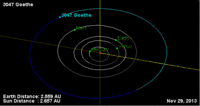3047 Goethe
3047 Goethe, provisional designation 6091 P-L, is a bright background asteroid from the central regions of the asteroid belt, approximately 6 kilometers (3.7 miles) in diameter. It was discovered on 24 September 1960, by Dutch astronomer couple Ingrid and Cornelis van Houten on photographic plates taken by Dutch–American astronomer Tom Gehrels at the Palomar Observatory in California, United States.[1] The asteroid was named after German poet Johann Wolfgang von Goethe.[1]
| Discovery [1] | |
|---|---|
| Discovered by | C. J. van Houten I. van Houten G. T. Gehrels |
| Discovery site | Palomar Obs. |
| Discovery date | 24 September 1960 |
| Designations | |
| (3047) Goethe | |
Named after | Johann Wolfgang von Goethe (German poet)[1] |
| 6091 P-L · 1969 UG 1976 JU6 · 1982 VO | |
| main-belt [1][2] · (middle) background [3] | |
| Orbital characteristics [2] | |
| Epoch 23 March 2018 (JD 2458200.5) | |
| Uncertainty parameter 0 | |
| Observation arc | 57.34 yr (20,943 d) |
| Aphelion | 2.7144 AU |
| Perihelion | 2.5698 AU |
| 2.6421 AU | |
| Eccentricity | 0.0274 |
| 4.29 yr (1,569 d) | |
| 103.04° | |
| 0° 13m 46.2s / day | |
| Inclination | 1.6105° |
| 317.26° | |
| 78.267° | |
| Physical characteristics | |
Mean diameter | 5.846±0.117 km[4] |
| 0.362±0.052[4] | |
| 12.9[2] | |
Orbit and classification

Goethe is a non-family asteroid of the main belt's background population.[3] It orbits the Sun in the central asteroid belt at a distance of 2.6–2.7 AU once every 4 years and 3 months (1,569 days; semi-major axis of 2.64 AU). Its orbit has a low eccentricity of 0.03 and a low inclination of 2° with respect to the ecliptic.[2] The body's observation arc begins with its official discovery observation at Palomar in September 1960.[1] In May 2156, it will pass at 7,440,000 km (0.0497 AU) from the asteroid 29 Amphitrite at a relative velocity of 1.66 km/s.[2]
Physical characteristics
According to the survey carried out by the NEOWISE mission of NASA's Wide-field Infrared Survey Explorer, Goethe measures 5.846 kilometers in diameter and its surface has a notably high albedo of 0.362.[4] As of 2018, no rotational lightcurve of Goethe has been obtained from photometric observations. The body's rotation period, pole and shape remain unknown.[2]
Palomar–Leiden survey
The survey designation "P-L" stands for Palomar–Leiden, named after Palomar Observatory and Leiden Observatory, which collaborated on the fruitful Palomar–Leiden survey in the 1960s. Gehrels used Palomar's Samuel Oschin telescope (also known as the 48-inch Schmidt Telescope), and shipped the photographic plates to Ingrid and Cornelis van Houten at Leiden Observatory where astrometry was carried out. The trio are credited with the discovery of several thousand asteroid discoveries.[5]
Naming
This minor planet was named after German poet and playwright Johann Wolfgang von Goethe (1749-1832).[1] The official naming citation was published by the Minor Planet Center on 29 September 1985 (M.P.C. 10045).[6] The Goethe Basin on Mercury was also named in his honor.[7]
References
- "3047 Goethe (6091 P-L)". Minor Planet Center. Retrieved 26 March 2018.
- "JPL Small-Body Database Browser: 3047 Goethe (6091 P-L)" (2018-01-26 last obs.). Jet Propulsion Laboratory. Retrieved 26 March 2018.
- "Asteroid 3047 Goethe – Proper Elements". AstDyS-2, Asteroids – Dynamic Site. Retrieved 29 October 2019.
- Masiero, Joseph R.; Mainzer, A. K.; Grav, T.; Bauer, J. M.; Cutri, R. M.; Dailey, J.; et al. (November 2011). "Main Belt Asteroids with WISE/NEOWISE. I. Preliminary Albedos and Diameters". The Astrophysical Journal. 741 (2): 20. arXiv:1109.4096. Bibcode:2011ApJ...741...68M. doi:10.1088/0004-637X/741/2/68. Retrieved 26 March 2018.
- "Minor Planet Discoverers". Minor Planet Center. 2018. Retrieved 26 March 2018.
- "MPC/MPO/MPS Archive". Minor Planet Center. Retrieved 26 March 2018.
- "3047 Goethe". Gazetteer of Planetary Nomenclature. USGS Astrogeology Research Program.
External links
- Asteroid Lightcurve Database (LCDB), query form (info)
- Dictionary of Minor Planet Names, Google books
- Asteroids and comets rotation curves, CdR – Observatoire de Genève, Raoul Behrend
- Discovery Circumstances: Numbered Minor Planets (1)-(5000) – Minor Planet Center
- 3047 Goethe at AstDyS-2, Asteroids—Dynamic Site
- 3047 Goethe at the JPL Small-Body Database
